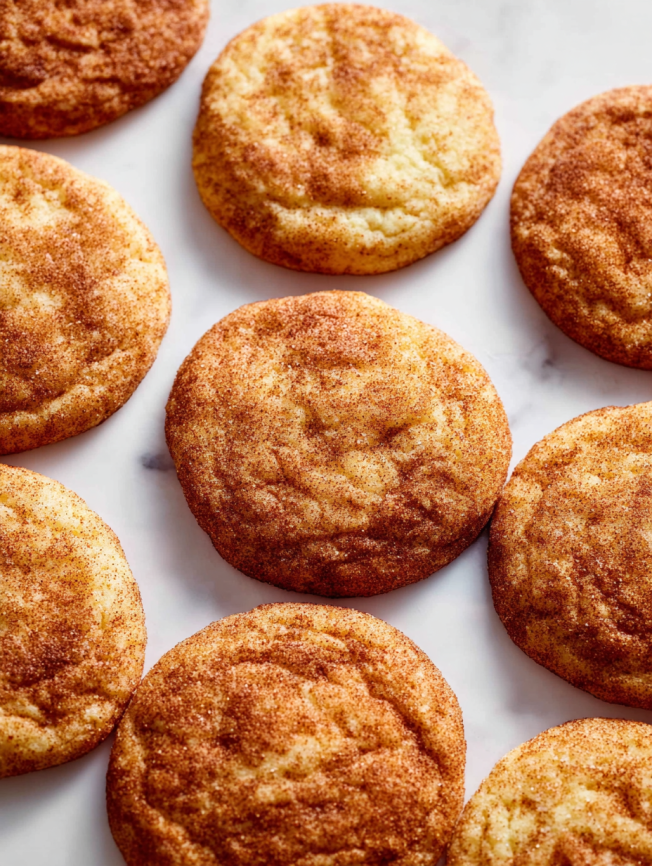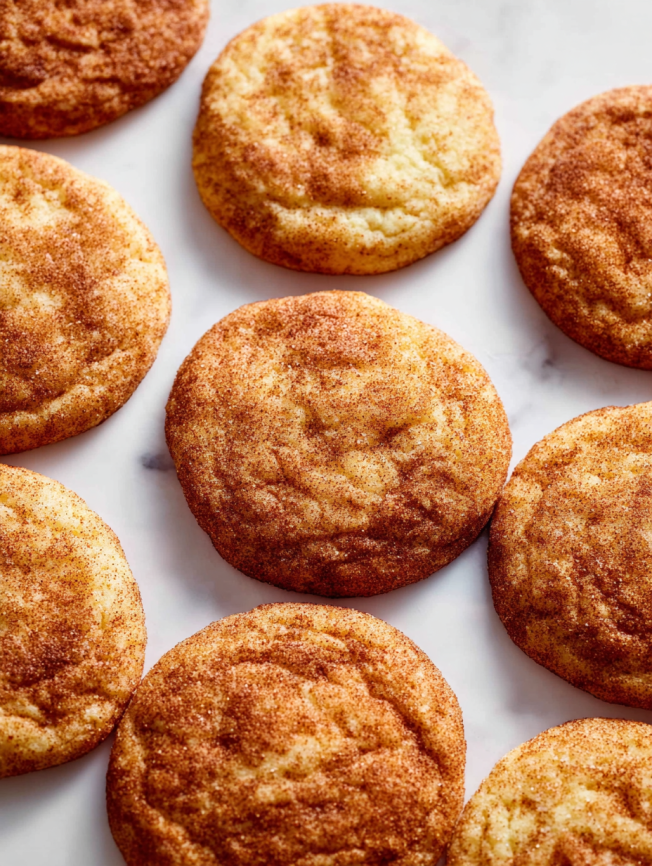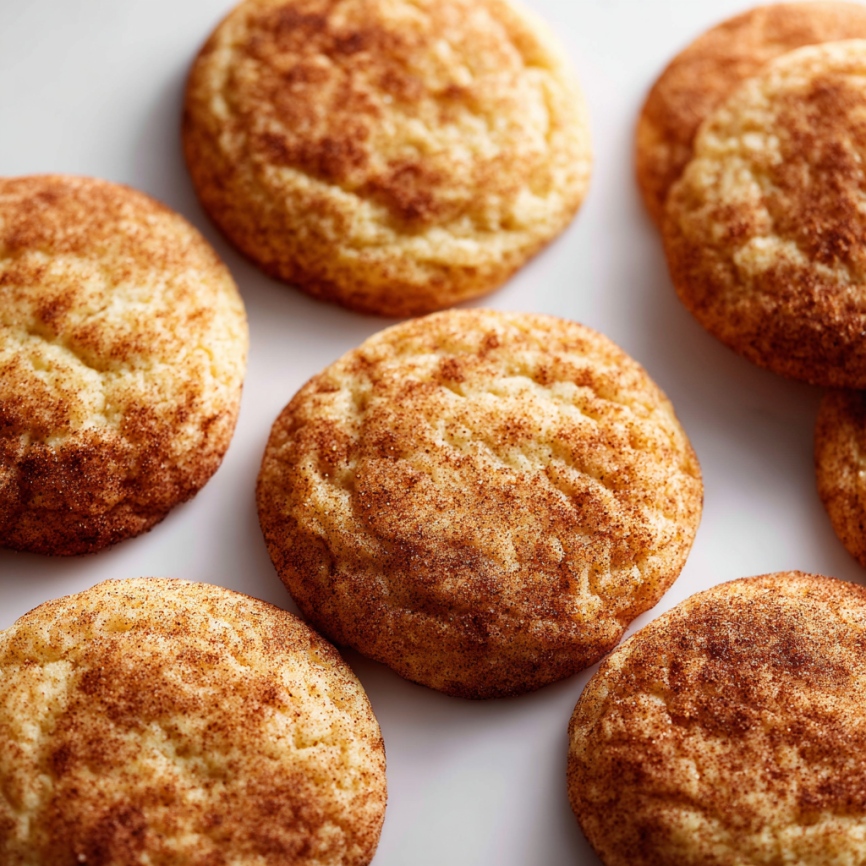Walking into my grandmother’s kitchen on baking day meant one thing – the irresistible aroma of cinnamon and sugar dancing through the air. Her snickerdoodles were legendary in our family, with their perfectly golden edges and impossibly soft centers that melted in your mouth. After years of trying to recreate that magic, I’ve finally perfected the recipe that captures everything I loved about those childhood memories.
These aren’t just any ordinary cookies. The secret lies in achieving that perfect balance between a crispy, caramelized exterior and a tender, buttery interior that practically dissolves on your tongue. Every bite delivers the warm comfort of cinnamon sugar wrapped in the most luxurious cookie texture imaginable.
Why These Snickerdoodles Will Become Your New Obsession
Texture Perfection
What sets these cookies apart is their incredible dual texture – crisp, golden edges that provide the perfect contrast to soft, pillowy centers. The combination of cream of tartar and baking soda creates the ideal chemical reaction for this textural masterpiece.
Flavor Complexity
Beyond the obvious cinnamon-sugar coating, these cookies develop deep, caramelized flavors from the combination of white and brown sugars. The cream of tartar adds a subtle tanginess that enhances the overall flavor profile without being detectable.
Foolproof Technique
This recipe eliminates the guesswork that often leads to disappointing snickerdoodles. With clear indicators for doneness and flexible shaping options, you’ll achieve bakery-quality results every single time.
Customizable Results
Whether you prefer thick, chewy cookies or thin, crispy ones, this single recipe accommodates both preferences with simple technique adjustments. The choice is entirely yours.
Essential Ingredients
Cookie Base
- 1 cup unsalted butter (softened to room temperature)
- 1 1/4 cups white granulated sugar
- 2 tablespoons light brown sugar (packed)
- 2 large eggs
- 2 teaspoons pure vanilla extract
- 2 3/4 cups all-purpose flour (or plain flour)
- 1 teaspoon cream of tartar
- 1/2 teaspoon baking soda
- 1 teaspoon salt
Cinnamon Sugar Coating
- 5 tablespoons white granulated sugar
- 2 tablespoons ground cinnamon
Prep Time: 20 minutes
Cook Time: 10 minutes
Servings: 24 cookies
Step-by-Step Instructions
Preparation Phase
Begin by preheating your oven to 350°F (175°C). Line your baking sheets with parchment paper or silicone baking mats, ensuring you have enough space for cookies that will spread during baking.
Creating the Perfect Base
In a large mixing bowl, cream the softened butter with both sugars until the mixture becomes light and fluffy – this process should take about 5 minutes with an electric mixer. Don’t rush this step; proper creaming incorporates air and creates the foundation for your cookies’ tender texture.
Next, beat in the eggs one at a time, followed by the vanilla extract. Continue mixing for an additional 2 minutes until everything is thoroughly incorporated and the mixture appears smooth and well-combined.
Incorporating Dry Ingredients
In a separate bowl, whisk together the flour, cream of tartar, baking soda, and salt. Gradually fold these dry ingredients into the butter mixture until just combined. Overmixing at this stage can result in tough cookies, so stop as soon as you no longer see streaks of flour.
Preparing the Coating
While your dough rests, combine the granulated sugar and cinnamon in a small bowl, whisking thoroughly to ensure even distribution. This coating will create that signature sparkly exterior that makes snickerdoodles so visually appealing.
Chilling and Shaping
Cover your dough and refrigerate for approximately 30 minutes if time allows. This chilling step helps prevent excessive spreading and contributes to the cookies’ soft centers.
Shaping Options
For Thick, Chewy Cookies
Scoop the dough directly onto your baking sheets using a cookie scoop or spoon, maintaining the natural mounded shape. Avoid rolling into perfect balls – you want height rather than width to achieve thick, bakery-style cookies.
For Thin, Crispy Cookies
Roll the dough into smooth balls using about 1 1/2 tablespoons per cookie. Before coating, gently press the center of each ball to create a slight indentation, which encourages spreading during baking.
Coating and Baking
Roll each portion of dough in the cinnamon-sugar mixture until completely coated. Place cookies at least 3 inches apart on your prepared baking sheets – they need room to spread. Sprinkle any remaining cinnamon sugar over the tops for extra coverage and visual appeal.
Bake for 10-11 minutes, watching carefully during the final minutes. The edges should be golden brown while the centers still appear slightly soft and underbaked.
Cooling and Storage
Proper Cooling Technique
Allow cookies to cool on the baking sheet for 10-15 minutes before transferring. This resting period lets them set properly while maintaining their soft centers. Moving them too quickly can cause breakage or loss of that perfect texture.
Storage Solutions
Store completely cooled cookies in an airtight container at room temperature for 5-6 days. Layer them between sheets of parchment paper to prevent sticking and maintain their delicate coating.
Serving Suggestions
Classic Presentations
Serve these cookies at room temperature to fully appreciate their soft, tender texture. They’re perfect alongside a glass of cold milk, hot coffee, or warm apple cider during autumn months.
Special Occasion Ideas
Create an elegant dessert by serving warm cookies with vanilla ice cream and a drizzle of caramel sauce. The contrast between the warm, spiced cookie and cold ice cream creates an unforgettable experience.
Holiday Presentations
During the holidays, arrange these cookies on decorative platters alongside other classic treats. Their golden color and sparkling cinnamon coating make them naturally festive and visually appealing.

Recipe Variations
Flavor Enhancements
Transform these cookies by adding 1/2 teaspoon of cardamom to the cinnamon sugar mixture for a sophisticated twist. Alternatively, incorporate 1 teaspoon of almond extract along with the vanilla for a subtle nutty undertone.
Texture Modifications
For extra soft centers, slightly underbake the cookies by 1-2 minutes. Conversely, extend baking time by 1-2 minutes for crispier results throughout.
Seasonal Adaptations
Create pumpkin spice snickerdoodles by adding 1/4 teaspoon each of nutmeg and ginger to your cinnamon sugar mixture. During the holidays, try adding a pinch of cloves for a festive variation.
Size Variations
Make mini snickerdoodles using 1 tablespoon of dough per cookie and reduce baking time to 8-9 minutes. Alternatively, create jumbo cookies with 3 tablespoons of dough each, extending baking time to 12-14 minutes.
Make-Ahead Tips
Dough Storage
The cookie dough can be prepared up to 3 days in advance and stored covered in the refrigerator. Allow it to come to room temperature for 15 minutes before shaping and baking for easier handling.
Freezing Options
Freeze shaped, uncoated cookie dough balls on baking sheets for 2 hours, then transfer to freezer bags for up to 3 months. Bake directly from frozen, adding 1-2 extra minutes to the baking time, and coat with cinnamon sugar while still warm.
Baked Cookie Storage
Completely cooled cookies freeze beautifully for up to 2 months when wrapped individually in plastic wrap and stored in freezer bags. Thaw at room temperature for 30 minutes before serving.
Professional Techniques and Tips
Butter Temperature Matters
Properly softened butter should give slightly when pressed but still hold its shape. Butter that’s too soft creates cookies that spread excessively, while butter that’s too cold won’t cream properly, resulting in dense cookies.
The Science of Cream of Tartar
Cream of tartar serves multiple purposes in this recipe. It provides the characteristic tangy flavor associated with snickerdoodles while also acting as an acidic component that reacts with the baking soda for optimal leavening.
Sugar Creaming Technique
Thorough creaming of butter and sugar is crucial for achieving light, tender cookies. The process incorporates air and partially dissolves the sugar crystals, creating the ideal base for your cookie dough.
Doneness Indicators
Perfect snickerdoodles should have golden-brown edges while the centers still appear slightly soft and puffy. The cookies will continue to set as they cool on the baking sheet, so don’t overbake in pursuit of firm centers.
Troubleshooting Common Issues
Preventing Over-Spreading
If your cookies spread too much, ensure your butter isn’t overly soft and consider chilling the shaped dough for 15 minutes before baking. Additionally, check that your baking soda and cream of tartar are fresh and active.
Achieving Soft Centers
Underbaking slightly is key to maintaining soft centers. Remove cookies when edges are golden but centers still look underdone – they’ll finish cooking on the hot baking sheet.
Cinnamon Sugar Adhesion
For better coating adhesion, roll cookies in cinnamon sugar immediately after shaping while the dough is still slightly tacky. Press gently to help the coating adhere properly.
Notes
Room temperature ingredients mix more easily and create better texture, so plan ahead to remove eggs and butter from the refrigerator 1-2 hours before baking.
Fresh cream of tartar makes a significant difference in both flavor and texture. Replace yours if it’s been in your pantry for more than two years.
Different brands of cinnamon can vary significantly in strength and flavor. Ceylon cinnamon provides a sweeter, more delicate taste, while cassia cinnamon offers the bold flavor most Americans expect in snickerdoodles.

Frequently Asked Questions
Q: Why do my snickerdoodles turn out flat instead of thick? A: Flat cookies usually result from butter that’s too warm, old leavening agents, or insufficient flour. Ensure your butter is properly softened (not melted), check expiration dates on baking soda and cream of tartar, and measure flour accurately.
Q: Can I make these cookies without cream of tartar? A: While cream of tartar is traditional and provides the characteristic tang, you can substitute with 2 teaspoons of baking powder in place of the cream of tartar and baking soda combination. The flavor will be slightly different but still delicious.
Q: How can I make my cookies more chewy? A: For chewier cookies, slightly underbake them and store with a slice of bread in your airtight container. The moisture from the bread helps maintain chewiness.
Q: Why don’t my cookies have that characteristic cracked top? A: The cracked appearance comes from proper leavening and not flattening the dough balls too much before baking. Ensure your cream of tartar and baking soda are fresh, and avoid pressing down on the dough.
Q: Can I use salted butter instead of unsalted? A: Yes, but reduce the added salt to 1/2 teaspoon to prevent the cookies from becoming too salty. Unsalted butter gives you better control over the final flavor balance.
Q: How do I prevent the cinnamon coating from falling off? A: Roll the cookies in cinnamon sugar just before baking, and press the coating gently into the dough surface. Adding a light sprinkle of additional coating right before baking also helps ensure coverage.
Nutritional Information (per cookie):
- Calories: 182
- Carbohydrates: 25g
- Protein: 2g
- Fat: 8g
- Saturated Fat: 5g
- Fiber: 1g
- Sugar: 14g

